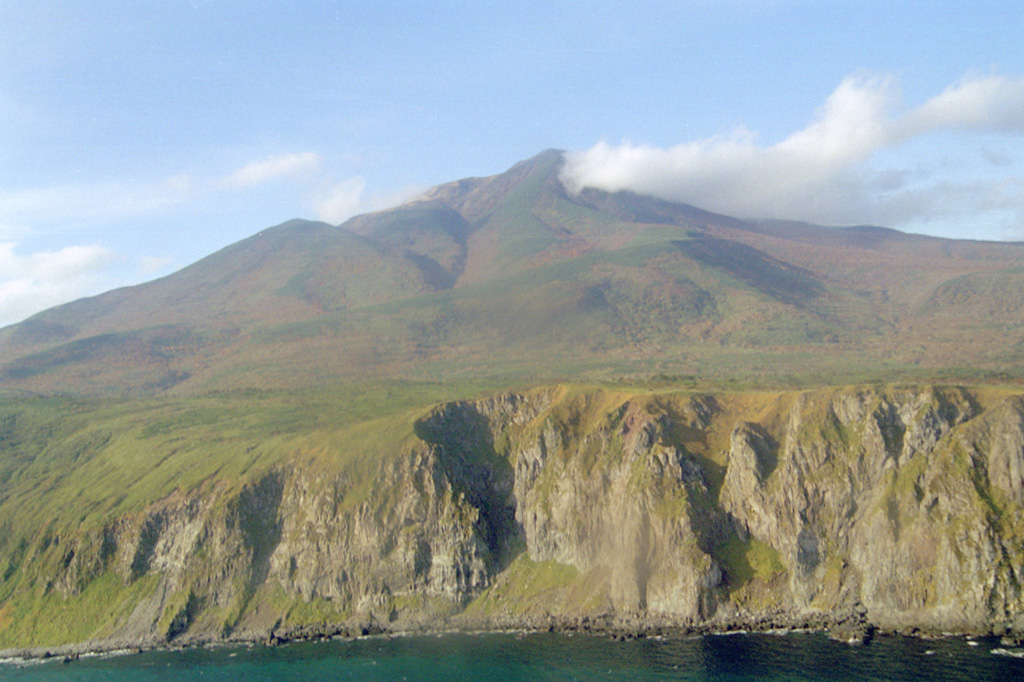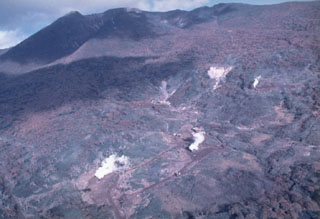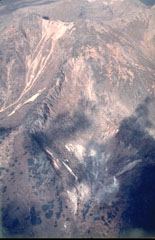

1991 hydrothermal explosion near geothermal drillhole
Many hot and boiling mineralized springs are active near Baransky. Geothermal surveys have been carried out in a zone 2-4 km SW of the volcano, and a geothermal station is being built there. Temperature data from several boreholes show a strong increase in 1989, 4-5 months before the eruption of Ivan Grozny, 13 km SW. Temperatures decreased after the eruption. Gas composition (table 1), temperature, and location of fumaroles in the SW-flank explosion crater remained unchanged in 1990-91.
Table 1. Composition of gases from the Baransky area: fumaroles in the SW-flank explosion crater (samples 1-4); the bottom of the Kipyaschaya River drainage (6); geothermal drillholes (7-8). Analyses by U.A. Taran and U.A. Ignatorich. Data courtesy of G. Steinberg.
| Sample | 1 | 2 | 3 | 4 | 5 | 6 | 7 | 8 |
| Temp. (°C) | 100 | 99 | 100 | 101 | 98 | 61 | 170 | 47 |
| H2O (mole %) | 75.5 | 85.8 | 97.01 | 98.7 | 99.1 | -- | 99.94 | -- |
| Volume % of dry gas | ||||||||
| CO2 | 92.45 | 94.20 | 94.20 | 91.20 | 58.24 | 33.00 | 70.0 | 88.0 |
| H2S | 5.71 | 4.60 | 4.51 | 6.00 | 33.0 | 2.2 | 15.1 | 0 |
| SO2 | 0.18 | 0.15 | -- | -- | -- | -- | -- | -- |
| H2 | 0.001 | 0.002 | 0.006 | 0.001 | 0.064 | 0.001 | 9.7 | 0.003 |
| CH4 | 0.073 | 0.070 | 0.10 | 0.01 | 1.27 | 1.20 | 3.3 | 0.03 |
| HCl | 0.01 | 0 | 0 | 0 | 0.01 | -- | -- | -- |
| N2 | 1.22 | 1.18 | 1.20 | 2.10 | 7.43 | 63.0 | 11.0 | 12.0 |
An exploration well into a zone of hot water 4.5 km SW of the summit (in the Kipyaschaya River valley) was drilled in the summer of 1991. Drilling was temporarily halted in early August, but no casing was installed. Two weeks later, a hydrothermal explosion occurred ~50 m upslope, forming a crater >10 m in diameter. A mixture of vapor, water, and a large quantity of rock fragments was erupted for several days, destroying vegetation within 50 m. The explosion was believed to have occurred when hot water moved up the borehole after drilling ceased, and escaped through its uncased walls into a permeable fissured zone near the surface.
Information Contacts: G. Steinberg, Yuzhno-Sakhalinsk.
The Global Volcanism Program has no Weekly Reports available for Sashiusudake [Baransky].
Reports are organized chronologically and indexed below by Month/Year (Publication Volume:Number), and include a one-line summary. Click on the index link or scroll down to read the reports.
Crater lake level drops; flank fumarolic activity
During observations 4-7 October 1987, five fumaroles in an explosion crater on the SW flank were forcefully emitting vapor. Jets rose 3-5 m and had temperatures of 99-107°C. In the summit crater, a 40-m-diameter explosion crater in the lava dome contained a smaller lake than in the past. The lake was <0.2 m deep, the surface was only 10 x 15 m, and the water was cold. Weak vaporization was occurring at two points on the dome (vaporizing temperatures are 40-45°C). No fumaroles were observed but there were many areas of sulfur deposits.
Information Contacts: G. Steinberg, Yuzhno-Sakhalinsk.
Fumarolic activity
During an October visit to the crater, activity remained at previous levels. Fumaroles were concentrated in five groups with gas temperatures ranging from 98 to 108°C. Gas was released under pressure in four of the five groups, to 2-6 m height.
Information Contacts: G. Steinberg, Yuzhno-Sakhalinsk.
1991 hydrothermal explosion near geothermal drillhole
Many hot and boiling mineralized springs are active near Baransky. Geothermal surveys have been carried out in a zone 2-4 km SW of the volcano, and a geothermal station is being built there. Temperature data from several boreholes show a strong increase in 1989, 4-5 months before the eruption of Ivan Grozny, 13 km SW. Temperatures decreased after the eruption. Gas composition (table 1), temperature, and location of fumaroles in the SW-flank explosion crater remained unchanged in 1990-91.
Table 1. Composition of gases from the Baransky area: fumaroles in the SW-flank explosion crater (samples 1-4); the bottom of the Kipyaschaya River drainage (6); geothermal drillholes (7-8). Analyses by U.A. Taran and U.A. Ignatorich. Data courtesy of G. Steinberg.
| Sample | 1 | 2 | 3 | 4 | 5 | 6 | 7 | 8 |
| Temp. (°C) | 100 | 99 | 100 | 101 | 98 | 61 | 170 | 47 |
| H2O (mole %) | 75.5 | 85.8 | 97.01 | 98.7 | 99.1 | -- | 99.94 | -- |
| Volume % of dry gas | ||||||||
| CO2 | 92.45 | 94.20 | 94.20 | 91.20 | 58.24 | 33.00 | 70.0 | 88.0 |
| H2S | 5.71 | 4.60 | 4.51 | 6.00 | 33.0 | 2.2 | 15.1 | 0 |
| SO2 | 0.18 | 0.15 | -- | -- | -- | -- | -- | -- |
| H2 | 0.001 | 0.002 | 0.006 | 0.001 | 0.064 | 0.001 | 9.7 | 0.003 |
| CH4 | 0.073 | 0.070 | 0.10 | 0.01 | 1.27 | 1.20 | 3.3 | 0.03 |
| HCl | 0.01 | 0 | 0 | 0 | 0.01 | -- | -- | -- |
| N2 | 1.22 | 1.18 | 1.20 | 2.10 | 7.43 | 63.0 | 11.0 | 12.0 |
An exploration well into a zone of hot water 4.5 km SW of the summit (in the Kipyaschaya River valley) was drilled in the summer of 1991. Drilling was temporarily halted in early August, but no casing was installed. Two weeks later, a hydrothermal explosion occurred ~50 m upslope, forming a crater >10 m in diameter. A mixture of vapor, water, and a large quantity of rock fragments was erupted for several days, destroying vegetation within 50 m. The explosion was believed to have occurred when hot water moved up the borehole after drilling ceased, and escaped through its uncased walls into a permeable fissured zone near the surface.
Information Contacts: G. Steinberg, Yuzhno-Sakhalinsk.
|
|
||||||||||||||||||||||||||
There is data available for 3 confirmed eruptive periods.
1951 Jul 15 ± 45 days Confirmed Eruption (Explosive / Effusive) VEI: 1
| Episode 1 | Eruption (Explosive / Effusive) | |||||||||||||||||||
|---|---|---|---|---|---|---|---|---|---|---|---|---|---|---|---|---|---|---|---|
| 1951 Jul 15 ± 45 days - Unknown | Evidence from Observations: Reported | ||||||||||||||||||
|
List of 2 Events for Episode 1
|
|||||||||||||||||||
1570 ± 30 years Confirmed Eruption (Explosive / Effusive)
| Episode 1 | Eruption (Explosive / Effusive) | ||||
|---|---|---|---|---|
| 1570 ± 30 years - Unknown | Evidence from Isotopic: 14C (uncalibrated) | |||
1460 ± 30 years Confirmed Eruption (Explosive / Effusive)
| Episode 1 | Eruption (Explosive / Effusive) | ||||
|---|---|---|---|---|
| 1460 ± 30 years - Unknown | Evidence from Isotopic: 14C (uncalibrated) | |||
This compilation of synonyms and subsidiary features may not be comprehensive. Features are organized into four major categories: Cones, Craters, Domes, and Thermal Features. Synonyms of features appear indented below the primary name. In some cases additional feature type, elevation, or location details are provided.
Synonyms |
||||
| Iiusu | Sachiusu-dake | Baranskii | Sashiusu-dake | ||||
Cones |
||||
| Feature Name | Feature Type | Elevation | Latitude | Longitude |
| Sashiusudake [Baransky] | Stratovolcano | |||
Craters |
||||
| Feature Name | Feature Type | Elevation | Latitude | Longitude |
| Kipyashchaya | Pleistocene caldera | |||
Thermal |
||||
| Feature Name | Feature Type | Elevation | Latitude | Longitude |
| Goluboe Ozero Hot Spring | Hot Spring | |||
| Okeanskoe | Thermal | |||
 The Sashiusudake volcanic complex consists of an eroded Pleistocene edifice with a younger Holocene cone and summit lava dome. Geothermal activity continues at a SW-flank exploration area, seen here from the west. A small hydrothermal explosion took place at an exploratory well there in 1992. An eruption occurred in 1951 when local inhabitants reported weak explosive activity at the summit.
The Sashiusudake volcanic complex consists of an eroded Pleistocene edifice with a younger Holocene cone and summit lava dome. Geothermal activity continues at a SW-flank exploration area, seen here from the west. A small hydrothermal explosion took place at an exploratory well there in 1992. An eruption occurred in 1951 when local inhabitants reported weak explosive activity at the summit. Steam rises from fumaroles on a SW-flank crater of Sashiusudake volcano on central Iturup Island with the summit crater visible at the top. A broad low lava dome, 500 m wide and 40-50 m high, occupies the crater, which has produced lava flows that cover wide areas on the northern and western flanks.
Steam rises from fumaroles on a SW-flank crater of Sashiusudake volcano on central Iturup Island with the summit crater visible at the top. A broad low lava dome, 500 m wide and 40-50 m high, occupies the crater, which has produced lava flows that cover wide areas on the northern and western flanks. The SE slopes of Sashiusudake tower above steep sea cliffs along the Pacific Ocean coast of Iturup Island. Lava flows descended 4-5 km SE to reach the ocean along a broad front N of where this photo was taken. An eruption in 1951 consisted of weak explosive activity at the summit. Geothermal activity continues from the summit and flank craters, and the SW-flank geothermal field contains hot springs and geysers.
The SE slopes of Sashiusudake tower above steep sea cliffs along the Pacific Ocean coast of Iturup Island. Lava flows descended 4-5 km SE to reach the ocean along a broad front N of where this photo was taken. An eruption in 1951 consisted of weak explosive activity at the summit. Geothermal activity continues from the summit and flank craters, and the SW-flank geothermal field contains hot springs and geysers.There are no samples for Sashiusudake [Baransky] in the Smithsonian's NMNH Department of Mineral Sciences Rock and Ore collection.
| Copernicus Browser | The Copernicus Browser replaced the Sentinel Hub Playground browser in 2023, to provide access to Earth observation archives from the Copernicus Data Space Ecosystem, the main distribution platform for data from the EU Copernicus missions. |
| MIROVA | Middle InfraRed Observation of Volcanic Activity (MIROVA) is a near real time volcanic hot-spot detection system based on the analysis of MODIS (Moderate Resolution Imaging Spectroradiometer) data. In particular, MIROVA uses the Middle InfraRed Radiation (MIR), measured over target volcanoes, in order to detect, locate and measure the heat radiation sourced from volcanic activity. |
| MODVOLC Thermal Alerts | Using infrared satellite Moderate Resolution Imaging Spectroradiometer (MODIS) data, scientists at the Hawai'i Institute of Geophysics and Planetology, University of Hawai'i, developed an automated system called MODVOLC to map thermal hot-spots in near real time. For each MODIS image, the algorithm automatically scans each 1 km pixel within it to check for high-temperature hot-spots. When one is found the date, time, location, and intensity are recorded. MODIS looks at every square km of the Earth every 48 hours, once during the day and once during the night, and the presence of two MODIS sensors in space allows at least four hot-spot observations every two days. Each day updated global maps are compiled to display the locations of all hot spots detected in the previous 24 hours. There is a drop-down list with volcano names which allow users to 'zoom-in' and examine the distribution of hot-spots at a variety of spatial scales. |
|
WOVOdat
Single Volcano View Temporal Evolution of Unrest Side by Side Volcanoes |
WOVOdat is a database of volcanic unrest; instrumentally and visually recorded changes in seismicity, ground deformation, gas emission, and other parameters from their normal baselines. It is sponsored by the World Organization of Volcano Observatories (WOVO) and presently hosted at the Earth Observatory of Singapore.
GVMID Data on Volcano Monitoring Infrastructure The Global Volcano Monitoring Infrastructure Database GVMID, is aimed at documenting and improving capabilities of volcano monitoring from the ground and space. GVMID should provide a snapshot and baseline view of the techniques and instrumentation that are in place at various volcanoes, which can be use by volcano observatories as reference to setup new monitoring system or improving networks at a specific volcano. These data will allow identification of what monitoring gaps exist, which can be then targeted by remote sensing infrastructure and future instrument deployments. |
| Volcanic Hazard Maps | The IAVCEI Commission on Volcanic Hazards and Risk has a Volcanic Hazard Maps database designed to serve as a resource for hazard mappers (or other interested parties) to explore how common issues in hazard map development have been addressed at different volcanoes, in different countries, for different hazards, and for different intended audiences. In addition to the comprehensive, searchable Volcanic Hazard Maps Database, this website contains information about diversity of volcanic hazard maps, illustrated using examples from the database. This site is for educational purposes related to volcanic hazard maps. Hazard maps found on this website should not be used for emergency purposes. For the most recent, official hazard map for a particular volcano, please seek out the proper institutional authorities on the matter. |
| IRIS seismic stations/networks | Incorporated Research Institutions for Seismology (IRIS) Data Services map showing the location of seismic stations from all available networks (permanent or temporary) within a radius of 0.18° (about 20 km at mid-latitudes) from the given location of Sashiusudake [Baransky]. Users can customize a variety of filters and options in the left panel. Note that if there are no stations are known the map will default to show the entire world with a "No data matched request" error notice. |
| UNAVCO GPS/GNSS stations | Geodetic Data Services map from UNAVCO showing the location of GPS/GNSS stations from all available networks (permanent or temporary) within a radius of 20 km from the given location of Sashiusudake [Baransky]. Users can customize the data search based on station or network names, location, and time window. Requires Adobe Flash Player. |
| DECADE Data | The DECADE portal, still in the developmental stage, serves as an example of the proposed interoperability between The Smithsonian Institution's Global Volcanism Program, the Mapping Gas Emissions (MaGa) Database, and the EarthChem Geochemical Portal. The Deep Earth Carbon Degassing (DECADE) initiative seeks to use new and established technologies to determine accurate global fluxes of volcanic CO2 to the atmosphere, but installing CO2 monitoring networks on 20 of the world's 150 most actively degassing volcanoes. The group uses related laboratory-based studies (direct gas sampling and analysis, melt inclusions) to provide new data for direct degassing of deep earth carbon to the atmosphere. |
| Large Eruptions of Sashiusudake [Baransky] | Information about large Quaternary eruptions (VEI >= 4) is cataloged in the Large Magnitude Explosive Volcanic Eruptions (LaMEVE) database of the Volcano Global Risk Identification and Analysis Project (VOGRIPA). |
| EarthChem | EarthChem develops and maintains databases, software, and services that support the preservation, discovery, access and analysis of geochemical data, and facilitate their integration with the broad array of other available earth science parameters. EarthChem is operated by a joint team of disciplinary scientists, data scientists, data managers and information technology developers who are part of the NSF-funded data facility Integrated Earth Data Applications (IEDA). IEDA is a collaborative effort of EarthChem and the Marine Geoscience Data System (MGDS). |